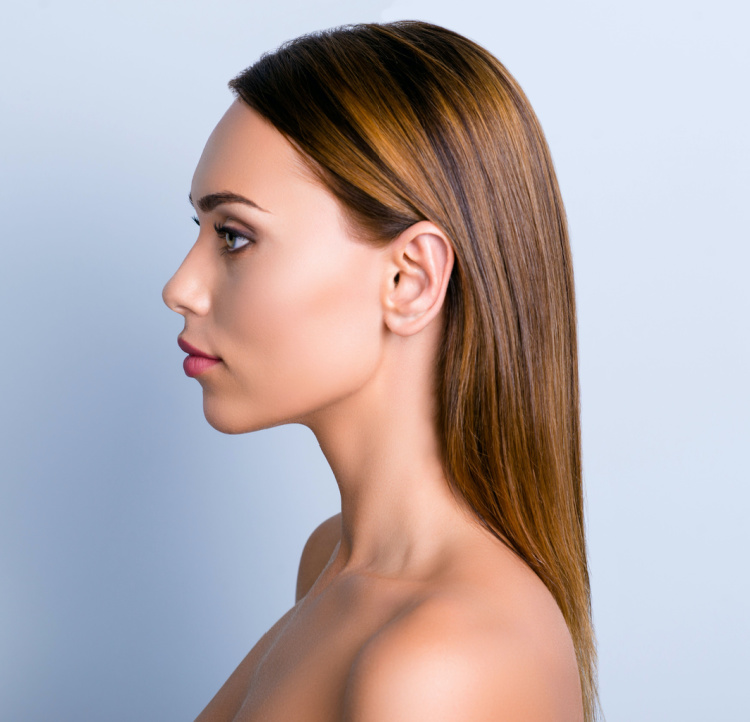Procedure
Nose Surgery (Rhinoplasty)
For both women and men who are unsatisfied with the appearance of their nose, Dr. Short can address these concerns through a Rhinoplasty procedure. Whether the concerns be cosmetic or functional, a rhinoplasty can help improve a patient’s overall aesthetic by restoring a balanced, proportional appearance to the nose.
To learn more about this rhinoplasty procedure or to determine the candidacy of a patient, please contact The Gillian Institute today and schedule a consultation.

Dr. Kimberly Short – Nasal Surgery Specialist
Dr. Kimberly Short is board-certified plastic surgery and has extensive training and experience working with international experts in the field of facial and nasal surgery. With a focus on the most advanced, beneficial techniques in nose reconstruction, Dr. Short completed her residency in Grand aids, Michigan.

What is Rhinoplasty?
A rhinoplasty is the cosmetic procedure that is designed to reshape a patient’s nose. Otherwise referred to as nose surgery, it is one of the most popular of all plastic surgery procedures. Patients often seek out a rhinoplasty for one of two different reasons: unhappiness with their overall facial harmony or if they require the procedure for reconstruction after an accident or physical trauma.
A rhinoplasty is often performed to reduce the size of a bump on someone’s bridge, but the treatment is capable of a wide range of results for enhancing the nose. A rhinoplasty can remove a hump on the bridge, narrow the span of the nostrils, change the angle between the upper lip and the nose, and reduce or increase the the nose’s overall size.
When Should I Consider a Rhinoplasty?
- A deformed appearance of the nose as a result of trauma or injury.
- Difficulty Breathing due to nose dysfunction.
- Chronic Sinus Infection.
- Loss of facial harmony due to a disproportionately large dorsal hump or large, pointed tip.
Candidates
Candidates for the rhinoplasty should be in overall good health, non-smokers, and at the age where facial growth is complete. Rhinoplasties are ideal for individuals with the following aims:
- Reducing or increasing the size of the nose
- Altering the size and shape of the nasal tip
- Removing humps on the bridge of the nose
- Straightening the nose
- Eliminating breathing difficulties
- Narrowing the span of the nostrils
- Changing the angle between the nose and upper lip
Consultation
Schedule a consultation with Dr. Short. Dr. Short will want to evaluate the patient’s particular case to help identify their concerns. While she understands that many teenagers have concerns about the appearance of their noses, she typically recommends they wait until their bodies are fully matured. Dr. Short will come up with a personalized plan for your procedure after she does a meticulous physical examination. It is advised that patients bring in photos of the ideal nose shape to help the doctor understand the aesthetic goals of the patient.
In turn, Dr. Short will also provide before and after photos of our previous Rhinoplasty patients to help give the patient a better idea of their rhinoplasty outcome. Patients should also be prepared to go over their medical history with Dr. Short, including past surgeries, routine medications, and current health conditions if any. Any adjustments to your medications will be discussed once the procedure has been scheduled and we will provide patients with a custom rhinoplasty quote before leaving our office. To schedule a consultation with Dr. Kimberly Short, please contact The Gillian Institute today!

Preparation
Proper preparation for the rhinoplasty surgery ensures that the patient’s experience will be successful. There are certain instructions that patients will be asked to follow before the procedure to help guarantee the success of the procedure. Patients will be given a prescription for pain medication to help alleviate discomfort during healing. This medication should be picked up ahead of time, so they are readily available during recovery.
Dr. Short will also recommend avoiding any medications that increase bleeding (such as anti-inflammatory drugs and herbal supplements) for a few weeks prior to surgery. If the patient smokes, they will be asked to quit at least three weeks before their procedure. Keep in mind that the patient will not be able to drive themselves home after the procedure, so they will need to arrange for a friend or family member to do so. Dr. Short will likely have further instructions once she’s given a full personal assessment.
It is important that patients refrain from blowing their nose forcefully during the recovery period, as it can negatively affect healing. While strenuous activities should be avoided for about a month, the patient is usually cleared to return to work after 5-7 days. Bruising and swelling underneath the eyes can last up to 10 days but will fade naturally. Patients can expect to notice an immediate improvement in the look and functionality of the nose once the splint comes off, but the best results will be seen in about six months.
The final results of a rhinoplasty may take a year to appear and are extremely long-lasting if not lifelong.